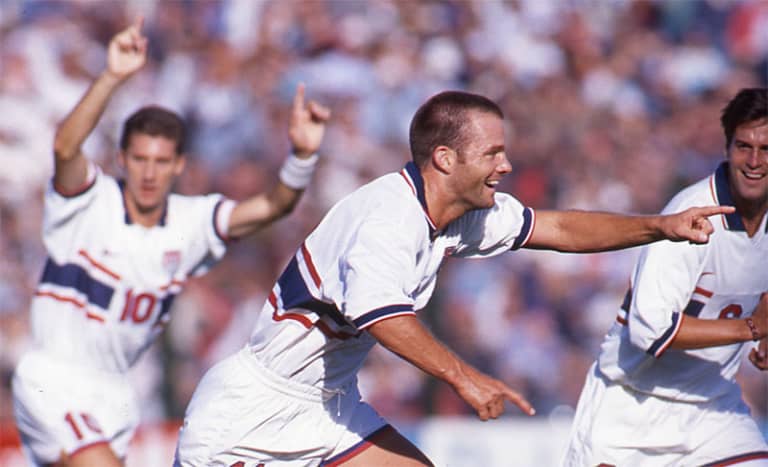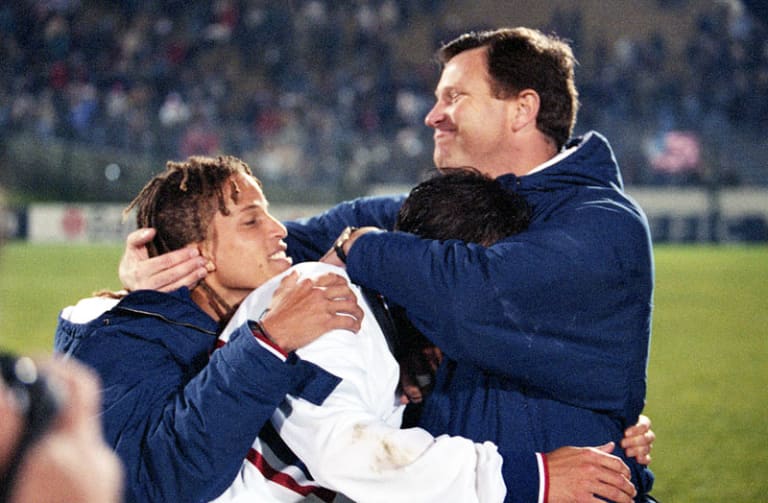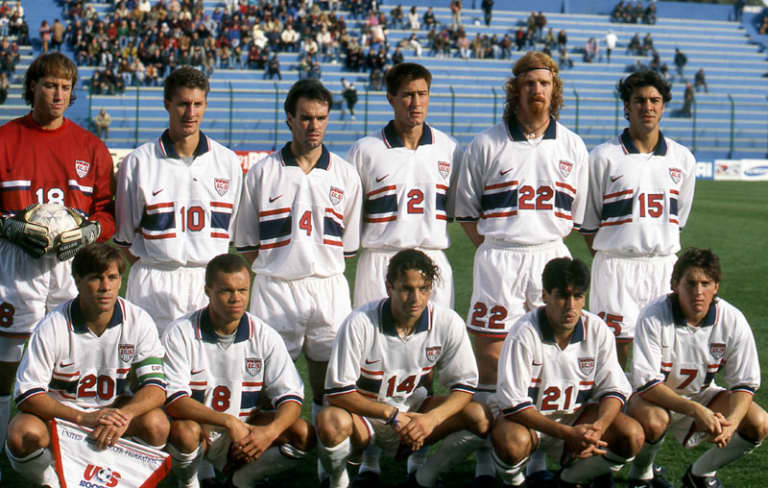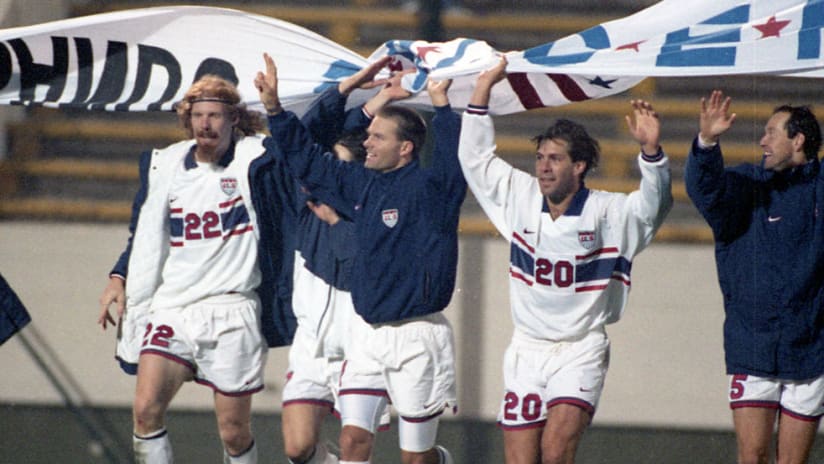IT'S HALFTIME AT THE ESTADIO PARQUE ARTIGAS in Paysandú, Uruguay. Improbably, the United States men's national team leads Argentina 2-0 in the last match of group play of the 1995 Copa América.
Inside the US locker room, the excitement of the first-half quickly gives way to disquiet as the Americans begin to grasp the stakes and the task that lies ahead of them. A single goal for Argentina could mean the difference between playing world champions Brazil in the quarterfinals or a familiar foe in Mexico. They know the proud Argentines will not quietly acquiesce.
As the team sat brooding over a second half that would determine their fates, the normally quiet and cerebral midfielder Tab Ramos suddenly spoke up.
“You guys realize,” Ramos told his teammates, “if we score one more goal, we'll win the group.”
What had seemed impossible before the match – that the Americans could not only defeat mighty Argentina, but also win their group – now seemed within reach. The US just had to reach out and grab it.
“Most people [would say] you beat Argentina 2-0 at halftime, you have to be thinking how do you hang on to win the game,” Ramos says now. “My thought was, 'No, we're going to hang on, but if we get one more we can be in first place and that would be a big deal.'”
Galvanized, the Americans ran back out onto the field confident that not only would they get that third goal, but that, in doing so, they would shock the world.

Eric Wynalda celebrates after scoring in the United States' 2-1 win against Chile during the 1995 Copa America group stages. Wynalda finished the tournament with three goals, tied for second-most overall. David Leah/Mexsport
ARE WE REALLY GOING TO GO THROUGH WITH THIS?
That was the question on every American player's mind the night before the team's first Copa América match against Chile. The team had already sat out all but one training session, and if their word was going to carry any weight with the U.S. Soccer Federation, they were going to have to sit out the next day's match as well.
The team had never intended to strike, but when the players reviewed the latest contract USSF offer on the plane trip to Uruguay, they were appalled by what they saw as an inequitable and disingenuous offer.
“We had been told that we were going to get an offer for the Copa América that would be substantially better than it had been in the past,” Wynalda recalls, “and that was not the case.”
An impromptu captains' meeting took place in the rear of the plane. After a brief discussion, the team's leaders resolved to strike for a better deal. Their teammates soon joined them in support.
Caught in the middle of the dispute was US interim head coach Steve Sampson. Earlier that spring, Sampson's predecessor, Bora Milutinovic, had been released from his contract by U.S. Soccer. Sampson, one of Milutinovic's most trusted assistants, was asked to step into the vacancy until the federation could find a more experienced international coach.
“I don't think anything truly prepares you to become a national team coach,” says Sampson, whose only head coaching experience up to that point had been at the University of Santa Clara. “You really have to experience it and learn on the job.”
But by late June, both of the federation's top two candidates – Carlos Queiroz and Carlos Alberto Parreira – had rejected its terms. Meanwhile, Sampson had earned the trust of his players and led his team to victory in that summer's U.S. Cup, beating star-studded Nigeria 3-2, smashing rival Mexico 4-0 and playing Colombia to a scoreless draw.
If Sampson could advance the US out of its Copa América group, observers thought, surely the federation would offer him the permanent position.
“[Sampson] was there to prepare a team and he didn't even know if he was going to have a team to coach in this tournament because it was unclear whether we were actually going to play or not,” defender Alexi Lalas remembers.
After the first few days in Uruguay, however, negotiations between the players and the federation had gone from bad to worse. Things had reached such an impasse that USSF Secretary General Hank Steinbrecher even threatened to send down the US Olympic team to play in the senior team's stead.
“I'm thinking to myself, 'Alright, I'm hired by the federation, so I have to coach whatever team they give me, so I'm not going to get involved in the politics of the negotiations,'” Sampsons recalls. “So I stayed completely out of it. I did not take the federation's side. I did not take the players' side. I basically told myself I was going to do my job; my staff and I are going to prepare the team once they come to terms with the federation.”
As the days slipped by, the likelihood increased that the players would sit out the match against Chile and Sampson's dream of shedding his interim tag would evaporate.
At almost the last possible moment, on the eve of the team's first match, the players and USSF finally agreed to terms on a new deal that would pay every player equally, regardless of whether that player played or how many caps he had. It was exactly what the veteran players had lobbied for – but now they had to back it up.
“It's all fine and good to have negotiated this deal,” Lalas remembers Sampson telling his players before the Chile match. “But none of it means anything if you're not able to produce consistently on the field. The reason why you're even in a position to negotiate an improved deal is because of your value on the field given your continued evolution and improvement.”
“That fired us up,” Lalas says. “We felt a responsibility after that … to go out and to do something, to live up to what we had negotiated.”
In the process, the drama and eventual resolution had also united the team – young and old – on the eve of a once-in-a-lifetime opportunity.
“We were fighting for something else other than the tournament, and that brought us closer together, especially the older guys,” says Gregg Berhalter, one of the roster’s youngest players. “All of those guys came together and really led by example, both on and off the field. I think that's what was special about it.”

After the US defeated Mexico in a penalty kick shootout in the quarterfinals, Cobi Jones and John Harkes found each other for a photogenic moment that only 6,500 spectators saw in person. David Leah/Mexsport
THROUGH TWO MATCHES, THE US HAD PERFORMED well above expectations. After defeating Chile 2-1 in their opener, the Americans lost a closely contested match against Bolivia, 1-0. That result was a tough one for the US. They’d dominated the match, playing some of their best attacking soccer of the tournament, only to give up a Marco Etcheverry golazo against the run of play.
Those results, though, were in the past. Ahead loomed Argentina.
In 1995, Argentina was as formidable an opponent as they had ever been. Against Chile and Bolivia, forwards Gabriel Batistuta and Abel Balbo had combined for five of the team's six goals. The Argentines had only conceded a single goal.
Even with the knowledge that Argentine head coach Daniel Passarella would rest some of his starters, the US knew they would be clear underdogs, especially considering that Paysandú was fewer than 15 miles from the border with Argentina.
“This would have been the [chance] for us to make our excuse, to just say, 'We're done. We have to play against the best team in the tournament. Let's pack it in … It's over,'” says Wynalda. “And we didn't do that.”
Against expectations, Sampson lined up in an attack-minded 3-5-2. With two deep-lying central midfielders, John Harkes and Thomas Dooley, Sampson hoped to disrupt Argentina's ground game, denying them the opportunities through midfield that had seen them roll past Chile and Bolivia.
From the opening whistle, the US contested every pass, bodies constantly swarming to the ball. When veteran defender Marcelo Balboa was substituted because of injury in the 15th minute, the American defense didn't skip a beat.
Then, unexpectedly, came the goals – both from unlikely sources.
While he had once been among the most accomplished players in the American player pool, winning three consecutive titles with Greek club AEK Athens from 1992-94, Frank Klopas seemed close to washed up when 1995 rolled around. He had suffered through multiple knee injuries, and there was no guarantee that he was the same explosive player he had once been.
But here he was, a starter in midfield against one of the best national teams in the world in what he knew was surely his last major international tournament, striking a deflected pass past the outstretched fingertips of Argentine goalkeeper Carlo Bossio and into the back of the net.
1-0 United States.
Eleven minutes later, Cobi Jones received a cross in the box from Eric Wynalda, cut by his man to the end line and sent a low pass across the face of goal. At the other end of that pass, redirecting it past Bossio, was none other than Lalas, making a run at goal all the way from his position in central defense.
2-0 United States.
“I just did what a soccer player does and made a near-post run,” recalls Lalas. “Whether I got there was irrelevant. I was looking at it purely from a soccer perspective. I'm going to make this near-post run. If it comes to me, great. If it doesn't, I'm drawing people to the near post and it goes to the back post.”
As both teams marched into the locker room at halftime, the Argentine fans whistled their countrymen off the pitch, while the locals of Paysandú stood and applauded the Americans' performance.
As the second half got under way, Passarella inserted his big guns into the match: attacking midfielder Ariel Ortega and hard-nosed midfielder Diego Simeone, who had gotten into a fight with Wynalda in the tunnel before the match. As the Americans had expected, Argentina was going to throw everything it had at the US in the second half.
Sampson made only one change, replacing Klopas with Ramos in an attempt to slow down the pace of the game. Ramos rewarded his coach when, in the 58th minute, he sprang Wynalda into open space with a deft left-footed pass. Wynalda's instinct, he says, was to hold the ball and wait for his teammates, but when he spotted Joe-Max Moore on the run in the box, instinct dictated he release the ball.
Moore slid feet first and got just enough of the ball to redirect it on goal. Wynalda, seeing the ball trickling towards the line, found himself in a footrace with Bossio for the ball.
“As soon as [Moore] hit it and I realized that this was a race between me, a goalkeeper and a defender, I knew I wasn't going to lose that race,” Wynalda remembers. “[Moore] says it was going in anyway, but I keep saying if I wouldn't have done that, [Bossio] would have slapped it out of there.”
3-0 United States.
Suddenly, against all odds, the US were in control of Group C and their own destiny.
Still, a single Argentine goal could sink the Americans' hopes. But despite a few scares – Simeone had two clear chances cleared off the line – goalkeeper Kasey Keller and the rest of the US defense stood firm.
When referee Márcio Rezende blew the final whistle, the locals, many of whom had warmly welcomed their American guests, now cheered the US players as heroes. They had taken down hated Argentina as thousands of traveling Argentines watched in horror from the stands.
The victory was a monumental achievement that earned Sampson the right to call himself the full-time coach, a position he held until his resignation after the 1998 World Cup.
“You can go back 100 years or you can go 100 years forward, and it's still an amazing result,” reflects Ramos. “You can't overlook that one. That's one of the best results ever.”

US head coach Steve Sampson embraces Cobi Jones and John Harkes after a victory against Mexico that reinforced the Americans' growing stature. “It was on neutral ground in the way that [it was] in 2002 [at the World Cup]. [Mexico] couldn't have any excuses,” Alexi Lalas says now. David Leah/Mexsport
THE WIN EARNED THE US A BERTH IN THE QUARTERFINALS and a rematch against Mexico. Less than a month earlier, the US had eviscerated their rivals 4-0 at RFK Stadium in Washington, D.C., and now El Tri sought revenge.
Far from shrinking from the fight, the Americans reveled in the Mexicans' hostility.
“Every time at that stage when we had the opportunity to play them, it was just something extra for us to prove to them that we're right behind you guys,” says Klopas. “We're catching you. We're coming. We're right there on your heels.”
For 90 exhausting minutes, the bitter rivals traded blows, neither able to find the breakthrough goal. Due to tournament rules, which hold true for the 2016 edition as well, the match skipped extra time and immediately advanced to penalty kicks, where the US felt supremely confident in their goalkeeper, Brad Friedel.
Friedel saved Mexico's second and third penalty kicks, while the American penalty takers – Wynalda, Moore, Paul Caligiuri and Klopas – buried theirs to send Mexico home and advance the US to an historic semifinal match against Brazil.
“You couldn't say, well you were playing away or well there was altitude or well you were in Columbus or all these different things,” says Lalas. “It was on neutral ground in the way that [it was] in 2002 [at the World Cup]. [Mexico] couldn't have any excuses.”

The US lost to Brazil in the semifinals, but made history by finishing atop their group and brushing aside Mexico in the quarterfinals. Head coach Steve Sampson's starting lineup against Colombia in the third-place game is pictured above. David Leah/Mexsport
A LITTLE MORE THAN A YEAR EARLIER, Brazil had knocked the US out of the 1994 World Cup with a demoralizing 1-0 victory in Palo Alto, California. Even with a man advantage in that match – Brazil's Leonardo was sent off for an elbow to the head that nearly ended Ramos's career – the US failed to create threatening chances on goal in the second half.
This time around, Sampson vowed to play a more proactive brand of soccer. He wanted to play the Brazilians straight up, or at least as straight up as the Americans could.
The US came out against Brazil with a far more offensive posture than they had the summer before, but it still wasn't good enough. The team once again failed to seriously test the Brazilian defense in a narrow 1-0 loss.
“We played a very intelligent, possession-minded, attacking-minded style of soccer,” says Sampson. “I believe any American fan that was watching at the time could truly have been proud of the way that our team played on that day. Even though we lost 1-0, it spoke volumes to what was about to come in the qualification phase [for the 1998 World Cup] and eventually beating Brazil in 1998 in the Gold Cup.”
In the third-place match against Colombia, the US, by then wracked with injuries and plagued by fatigue, fell 4-1, the lone goal a Moore penalty kick. It was a disappointing finish to an otherwise exceptional and unparalleled tournament performance.
“We had good players,” says midfielder Mike Sorber, now an assistant coach with the Philadelphia Union. “That's the one thing that gets overlooked and neglected. Everybody wants to talk about everything else except how good we were and we proved that game in and game out.”












